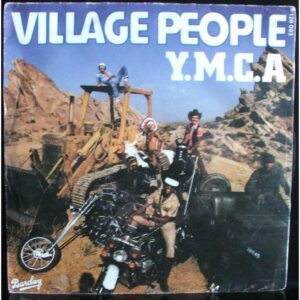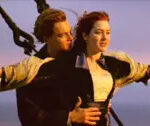The Village People’s “YMCA” is instantly recognizable. From school dances to sporting events, its catchy tune and iconic dance moves have made it a global phenomenon. Recently inducted into the Library of Congress’ National Recording Registry, with insights from author Josiah Howard, “YMCA” is more than just a fun disco track; it’s a cultural touchstone that unexpectedly became an unofficial anthem for the gay community and a song embraced by everyone. Let’s explore the story behind this enduring hit.

Alt text: Black and white promotional photo of the Village People for the YMCA song, featuring six members dressed in costumes representing different archetypes, including a police officer, construction worker, cowboy, Native American, biker, and soldier, posing closely together.
The Genesis of a Fantasy: Creating the Village People
The story of “YMCA” begins with the creation of the Village People themselves. Despite their contrasting backgrounds, the six men who formed the group were united by a shared ambition: achieving fame and fortune in the vibrant music scene of the late 1970s. This collective dream, fueled by tireless effort, would propel them to extraordinary heights, even if only for a fleeting period.
Mention the Village People today, and you’re likely to encounter a mix of reactions, from amusement to knowing smiles. Many immediately recall the signature dance, playfully forming the letters Y, M, C, and A with their arms. This immediate recognition underscores the band’s lasting impact on popular culture.
At their peak in the late 1970s and early 1980s, the Village People were a force to be reckoned with. They sold over 100 million records, landed three songs in the top ten of the pop charts, and dominated dance clubs with four top twenty hits. Their global tours, including sold-out shows at Madison Square Garden, and their feature film, “Can’t Stop the Music,” solidified their status as pop culture icons. Their music became ubiquitous, permeating discotheques, doctor’s offices, and even bar mitzvahs. Beyond mere entertainment, they were a financial powerhouse for Casablanca Records, as President Neil Bogart acknowledged, placing them alongside Donna Summer as the label’s top earners.
The concept for the Village People originated from French-Moroccan producers Jacques Morali and Henri Belolo, who had previously found success with the Ritchie Family. Their ambition for the Village People was even grander: to surpass the Ritchie Family’s achievements and reach the coveted number one spot on the Billboard pop charts.
Targeting a Niche, Achieving Mainstream Success
Their initial strategy was to target a specific audience. The 1977 debut album, “Village People,” was explicitly crafted for the gay disco scene. Comprising just four tracks and recorded with studio musicians and a relatively unknown singer, the album’s song titles clearly signaled its intended demographic: “Fire Island,” “San Francisco (You’ve Got Me),” “Village People,” and “In Hollywood (Everybody is a Star).” These titles referenced key locations and themes relevant to the gay community at the time.
Singer-songwriter Phil Hurtt played a crucial role in broadening the band’s appeal. Known for co-writing The Spinners’ hit “I’ll Be Around,” Hurtt refined Peter Whitehead’s original lyrics, making them more accessible to a wider audience. He also created the vocal arrangements and sang the guide vocals for the group. The music on this first album was created by Gypsy Lane, a group of talented Philadelphia-based musicians.
The visual identity of the Village People was as carefully constructed as their music. Each of the six members embodied a popular gay archetype. Victor Willis, a heterosexual African American singer, became the group’s frontman, initially as a “disco man” before adopting the Police Officer/Naval Officer persona. Alexander Briley, also African American and heterosexual, took on the roles of GI and Sailor, starting as a “street kid.” Felipe Rose, of Lakota Sioux and Puerto Rican heritage, became the iconic “Indian.” David Hodo was the Construction Worker, Glenn Hughes the Biker/Leather Man, and Randy Jones the Cowboy. Interestingly, only Willis and Rose were involved in the first album. The other members were recruited through a trade advertisement seeking “Macho Types” who could dance and had mustaches.
After intense rehearsals, the Village People made their live debut on February 28, 1978, at the Odyssey nightclub in Brooklyn, famously featured in “Saturday Night Fever.” This performance, launching a nationwide tour, featured the six costumed members backed by a live band, creating a spectacular twelve-man stage presence. Despite Randy Jones’s recollection of the audience being clad in typical disco attire, the Village People were a hit. The overt gay themes in their songs and costumes seemed to resonate with audiences, or perhaps were simply overlooked in favor of the catchy music and energetic performances. Casablanca Records and the band quickly realized they had a winning formula.
The “Macho Man” album in 1978 built upon the foundation of their debut. With six tracks, it continued to cater to their core audience with songs like “Key West,” “Just a Gigolo,” “I Am What I Am,” and “Sodom and Gomorrah.” However, the single “Macho Man” transcended these boundaries. Its chant-like chorus celebrating male physique and gym culture resonated with straight audiences as well, becoming a dance floor hit and reaching #25 on the Billboard charts.
The Unstoppable Rise of “YMCA”
In 1979, the album “Crusin’,” with its double entendre title alluding to gay cruising, propelled the Village People to superstardom. While it included songs like “I’m a Cruiser,” “My Roommate,” and “Hot Cop,” it was “Y.M.C.A.” that became their defining anthem.
“YMCA,” an ode to the Young Men’s Christian Association, initially established as a support system for World War II veterans, took on a different connotation in the Village People’s rendition. The song subtly suggested that the YMCA was not just a place for recreation and community but also a place to “hang out with all the boys.” Despite initial objections from the YMCA organization, an amicable settlement led to their embracing the unexpected publicity.
Victor Willis, however, consistently maintained that “YMCA” was “a song for everyone,” not just the gay community. He co-wrote it with Morali and Belolo, drawing inspiration from the four-syllable chant in their earlier song “San Francisco (You’ve Got Me).” “San-Fran-Cis-Co” transformed into “Y-M-C-A,” complete with energetic vocal embellishments.
Musically, “YMCA” is in G major and features distinct sections with brass arrangements by Horace Ott. Ott’s horns are prominent throughout, driving the 148 BPM track. The instrumentation includes a full orchestra, bass guitar, rhythm guitar, Fender Rhodes piano, clavinet, conga, timbale, triangle, and tambourine, all punctuated by syncopated hand claps, hinting at themes of sports and fitness. Victor Willis’s powerful lead vocals, described as a “husky-voiced church shout,” added soulfulness to the track.
“YMCA” reached number two in the US and topped charts in 15 other countries, setting it apart from its contemporaries. It echoed earlier songs celebrating city life and offering solace to the marginalized, such as Petula Clark’s 1964 hit “Downtown.” Both songs feature catchy choruses, celebrate urban freedom, provide sanctuary, and subtly appeal to a gay audience through lyrics suggesting companionship and understanding.
A Cultural Milestone and Enduring Legacy
Following “Crusin’,” the Village People released three more albums with Casablanca Records. “Go West” (1979) featured the hit “In The Navy,” and “Live & Sleazy” (1979) was a double album with both live and studio tracks. Their final major project was the soundtrack for the movie “Can’t Stop the Music” (1980). This film and soundtrack marked the end of their era as a dominant force in the music industry.
Nevertheless, “YMCA” has endured. It remains one of the few singles to have sold over ten million physical copies. It’s a staple in advertising, movies, television, and theater. The song’s iconic dance led to a Guinness World Record when 40,148 people performed it at the Sun Bowl. American astronauts even chose it as a wake-up call on the Space Shuttle mission STS-106.
“YMCA” transcended its status as a hit record to become a cultural milestone. It’s a global anthem rooted in gay culture and sensibilities that has been universally embraced. Over four decades after its release, “YMCA” remains the quintessential party song, enjoyed by people of all ages and backgrounds, from teenagers to heads of state, and yes, even construction workers, solidifying its place in music history.
Josiah Howard is a pop culture author with books including “Blaxploitation Cinema: The Essential Reference Guide” and “Cher: Strong Enough.” He is a senior contributor at Furious Cinema and lectures on film internationally.
* Disclaimer: The views expressed in this essay are those of the author and do not necessarily represent the views of the Library of Congress.

